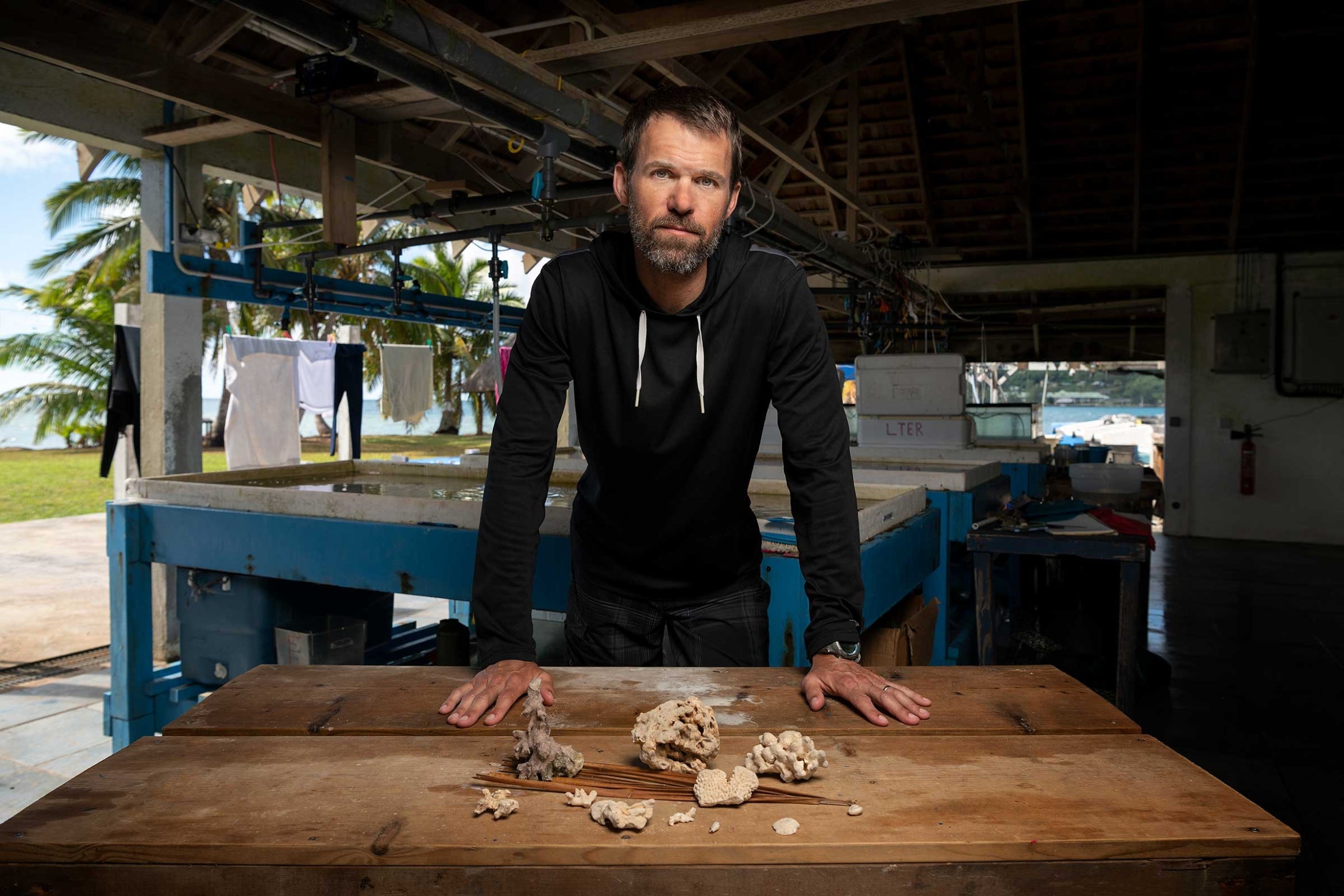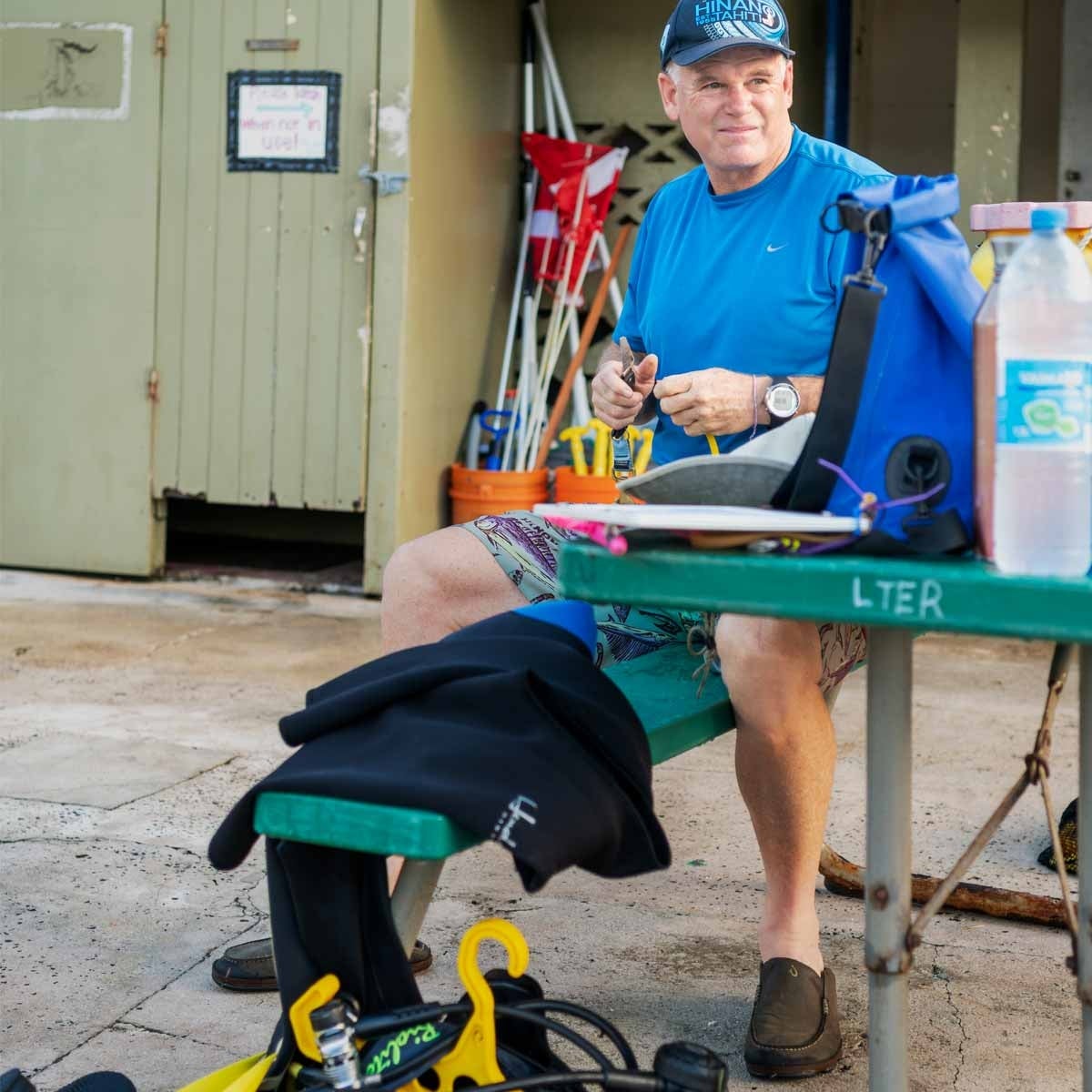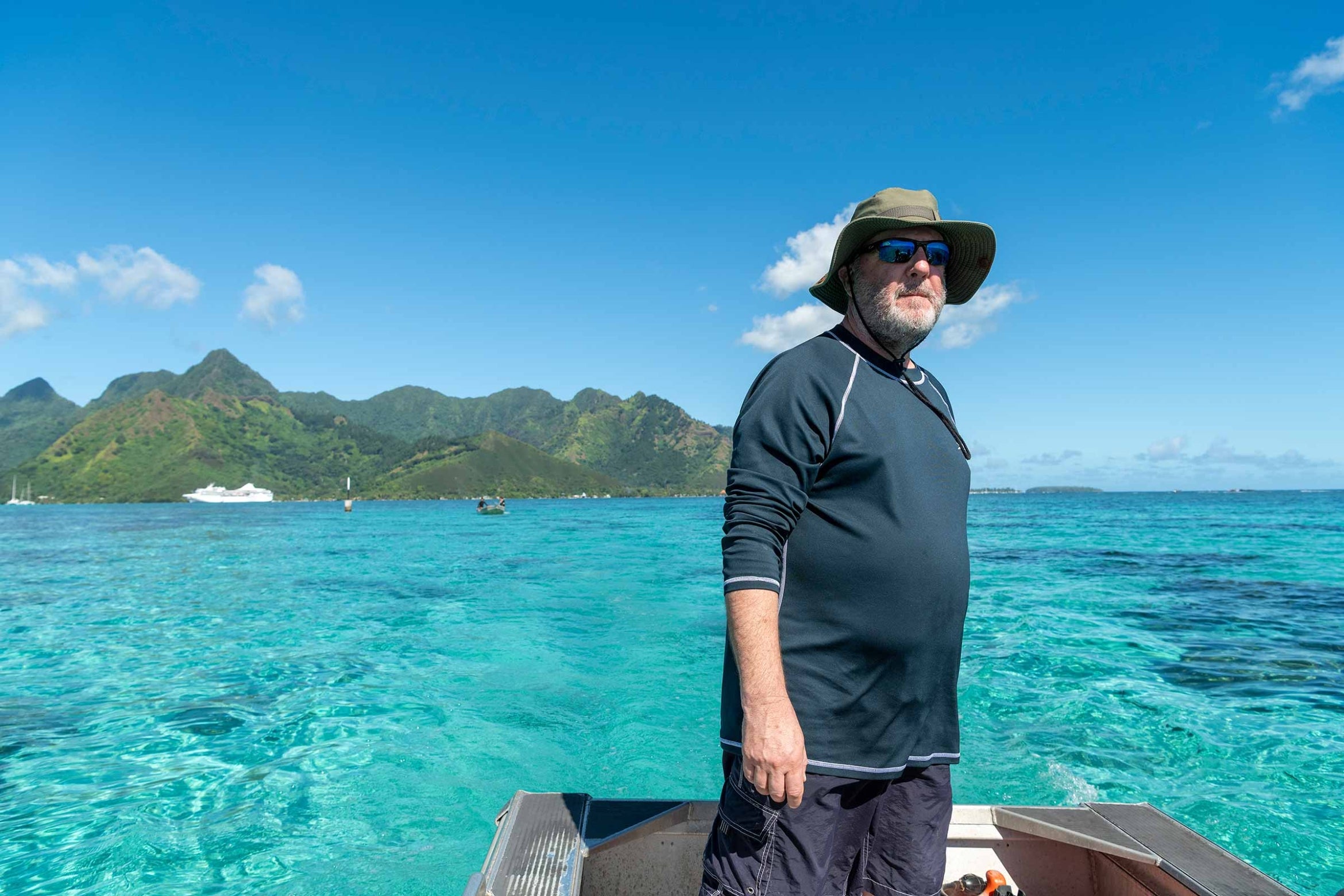Coral reefs are located in tropical oceans near the equator. They are most often found in warm, clear, shallow water that allows for plenty of sunlight to nurture the algae the coral rely on for food and energy.
Coral reefs also are one of the first ecosystems to be affected by global change.
Deron Burkepile
Marine biologist Deron Burkepile focuses most of his research on the coral reef system around Mo’orea. “One of the other things our group is working on is a global synthesis of coral bleaching, so we’re gathering data for the past 30 years on where coral bleaching has happened, how bad it’s been and how it relates to sea surface temperature, human population and pollution to understand the bright spots and the dark spots in the world’s reefs.”

Coral bleaching is a global occurrence, but some reefs are managing it better than others. “Understanding both the bright spots and the dark spots lets us potentially make different conservation decisions,” he explained.
One of the real powers of working at Gump Research Station is having access to decades of research data that Burkepile and his colleagues can use to help them understand the mechanisms of how coral reefs are disturbed by — and then recover from — coral bleaching events. “That puts us in a really good place to test some general ideas about how coral reefs function and run and recover, but also how humans impact the process,” he said.
“And we’re in a nice position because the reefs around Mo’orea are representative of coral reefs all over the central Pacific,” he went on. “So what we find out here in our long-term experiments really can inform the ideas about how coral reefs around the world will respond to their own disturbances and how we can potentially manage those disturbances and help the reefs recover faster.”
Another area of Burkepile’s research examines the impacts of human behavior on coral reef health: Nutrient pollution from agriculture, for example, or sedimentation or over-fishing all can weaken corals and make them more susceptible to disturbances such as increases in sea surface temperatures. “If corals are already affected by these human stressors, then even a minimal amount of stress from a temperature change can make them bleach sooner — or for a longer period — than they would otherwise,” he said.
Erika Eliason
Erika Eliason’s career choice has a direct family connection. “I fell into the field of marine science because of my grandfather,” she explained. “I grew up fishing with him, trolling for rainbow trout from the time I was knee high to a grasshopper.”
That led to an all-around love of camping and the great outdoors, but of fish specifically.
An assistant professor in the Department of Ecology, Evolution and Marine Biology, Erika Eliason focuses on ecological and evolutionary physiology in fish. “I study how animals work in an ecological setting,” she said. “Here at Gump Research Station I’m trying to understand how climate change is affecting fish populations.”
More specifically, she’s looking at how increasing temperatures are affecting fish metabolism and, consequently, their ability to thrive.
“All animals have an optimal range of temperature for performance,” Eliason explained. “For coral reef fishes it’s around 27, maybe 28 degrees Celsius.” When the temperature rises as few as three or four degrees, fish don’t manage well. Eliason and her team want to understand why.
“We think partly it’s because they have a reduced aerobic capacity to digest food,” she said. At Gump Research Station, Eliason and her team are measuring and comparing fishes’ aerobic capacity to digest a meal, to swim and simply to exist in varying water temperatures.
It could be that the higher temperatures impact the fishes’ digestion so they don’t eat as much as they would otherwise. “If you’re an herbivorous fish, you’re not going to clean off the corals, and the algae is going to take over.”
The effects are cascading: Increased temperatures might not be lethal to the fish, but they aren’t going to thrive, and that will have a huge effect on the whole coral ecosystem.
In related research, Eliason’s team is collaborating with marine biologist Deron Burkepile to measure the macro and micronutrients in fish excrement to understand how they might contribute to coral health. Corals depend on external sources of nutrients to thrive, and this may be particularly important during bleaching when corals expel their symbionts at warm temperatures. The team is trying to figure out which fishes’ poop may be most beneficial to corals
Hunter Lenihan
It was the television series “The Undersea World of Jacques Cousteau” that sparked Hunter Lenihan’s passion for the marine environment. “He introduced everyone to the undersea world through scuba, and that was absolutely what I wanted to do the rest of my life,” recalled the applied marine and fisheries ecologist who grew up near the San Francisco Bay.
“I became enthralled with the scientific process,” he continued. “I’m very interested in doing large-scale experiments underwater to find out how things work. And Mo’orea and the facilities at Gump Research Station enable “the most interesting large-scale experiments you can do underwater.”
A professor in the Bren School of Environmental Science & Management, Lenihan has been conducting experiments on and around Mo’orea since 2002. He visits the Gump Research Station sometimes as often as four times a year.
And when he says large-scale experiments, that’s what he means. “We have experiments all around the island at different sites, at 10- and 17-meters depth, in which we manipulate corals,” he said. “We move and remove colonies of different sizes to learn how different combinations influence coral populations.”

On Mo’orea, Lenihan’s primary research follows two separate courses. One is coral reef community ecology and the other is related to fisheries management. “I study the long-term changes in coral populations,” he said, “and use that information to create models that help us predict what the coral community should look like in the future.”
His research involving collaborative fisheries management brings him together with fishing communities and managers on Mo’orea to understand the impact of fishing on different populations of fish. “I work with communities to explore how they might change their behavior and keep track of their fishing efforts such that we can have sustainable catches over time,” Lenihan explained.
According to Lenihan, the research he and his colleagues conduct at Gump Research Station is important for understanding how humans influence their environment, and how that environment works. “One of the things we’re doing is tracking populations and communities of organisms that are being influenced by climate change,” he said. “This is an extremely good natural laboratory to quantify the effects on things like oceanographic patterns and ocean temperatures and how they impact the communities of organisms.”
Additionally, the community around Gump Research Station, with its economy, culture and interaction with the environment, offers a unique opportunity to understand where humans fit in the ecosystem. “That can be done on a manageable and tractable scale here in Mo’orea,” Lenihan said.
Andrew Brooks
Andrew Brooks grew up in Ohio and Michigan, about as far from an ocean as he could be. But through the magic of television he joined ocean explorer Jacques Cousteau on his worldwide adventures. “And when somebody told me that was actually a job, that you could be a marine biologist and do these things for a living,” he said, “that was a major Aha moment in my life.”
Now, Brooks is a senior project scientist at UC Santa Barbara and also deputy program director for the Mo’orea Coral Reef Long Term Ecological Research (MCR LTER) site.

“My research really centers around investigations involving population and community dynamics of marine organisms,” he said. “And in particular, I usually work on fishes. The primary goal of my research is to understand what types of things influence both the numbers and types of species that are present in a given ecosystem.”
In this case, it’s the numbers and types of fishes on the coral reefs around Mo’orea and the interactions that occur between those species and the reef itself.
“Most recently, I’ve been working on a project to construct 3-D models of the coral reef,” he continued. “It’s somewhat easy to go down and count all of the fish to get a good description of the species that make up the reef’s fish communities, but it’s much harder to get a really detailed physical description of the actual habitat that those fish are living in and interacting with.”
He’s using photogrammetry, a technique nearly as old as photography itself. However, only in the past 10 to 20 years have techniques in underwater surveying and photography been developed that allow photogrammetry to be used by marine ecologists.
Brooks and his team take a large number of photographs and then use computer software to stitch them together into a large, single mosaic of the reef. But it’s much more complex than simply creating a mosaic of images. “Photogrammetry also allows us to construct a detailed three-dimensional model of the coral reef down to the cm scale, and then using that three-dimensional model we can derive very precise measures to describe the complex 3-D structure of the reef,” he said.
The team then uses that detailed information on the three-dimensional structure of the reef in conjunction with the information they’ve gathered on the fishes that are found there to form a more detailed view of the relationship between the fish and their coral reef habitat.


